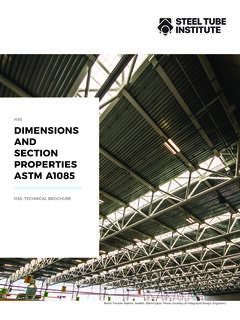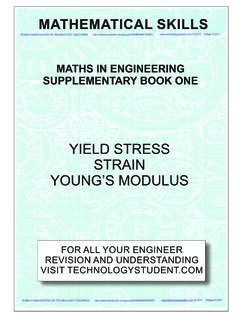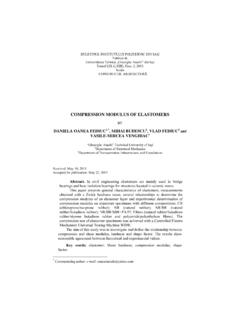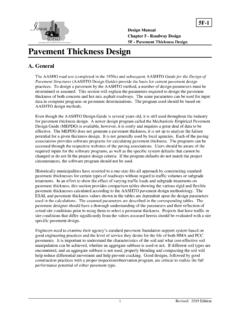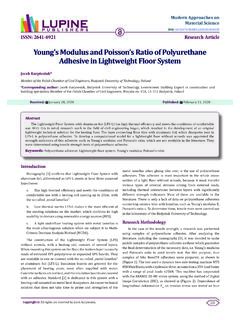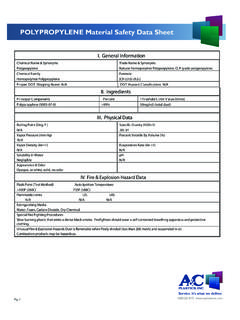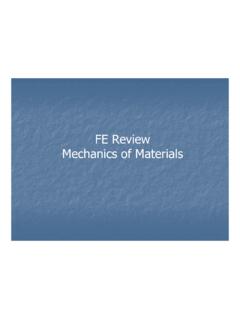Transcription of 6.13 In Section 2.6 it was noted that the net bonding ...
1 In Section it was noted that the net bonding energy EN between two isolated positive and negative ions is a function of interionic distance r as follows: EN=!Ar+Brn ( ) where A, B, and n are constants for the particular ion pair. Equation is also valid for the bonding energy between adjacent ions in solid materials. The modulus of elasticity E is proportional to the slope of the interionic force separation curve at the equilibrium interionic separation; that is, E!dFdr" # $ % & ' ro Derive an expression for the dependence of the modulus of elasticity on these A, B, and n parameters (for the two-ion system) using the following procedure: 1.
2 Establish a relationship for the force F as a function of r, realizing that F=dENdr 2. Now take the derivative dF/dr. 3. Develop an expression for r0, the equilibrium separation. Since r0 corresponds to the value of r at the minimum of the EN-versus-r curve (Figure ), take the derivative dEN/dr, set it equal to zero, and solve for r, which corresponds to r0. 4. Finally, substitute this expression for r0 into the relationship obtained by taking dF/dr. Solution This problem asks that we derive an expression for the dependence of the modulus of elasticity, E, on the parameters A, B, and n in Equation It is first necessary to take dEN/dr in order to obtain an expression for the force F; this is accomplished as follows: F =dENdr=d!
3 Ar" # $ % & ' dr+dBrn" # $ % & ' dr = Ar2!nBr(n+1) The second step is to set this dEN/dr expression equal to zero and then solve for r (= r0). The algebra for this procedure is carried out in Problem , with the result that r0 = AnB! " # $ % & 1/(1' n) Next it becomes necessary to take the derivative of the force (dF/dr), which is accomplished as follows: dFdr=dAr2! " # $ % & dr+d'nBr(n+1)! " # $ % & dr =!2Ar3+(n)(n+1)Br(n+2) Now, substitution of the above expression for r0 into this equation yields dFdr! " # $ % & r0='2 AAnB! " # $ % & 3/(1'n)+ (n)(n+1)BAnB!
4 " # $ % & (n+2)/(1'n) which is the expression to which the modulus of elasticity is proportional A cylindrical rod 100 mm long and having a diameter of mm is to be deformed using a tensile load of 27,500 N. It must not experience either plastic deformation or a diameter reduction of more than 10-3 mm. Of the materials listed as follows, which are possible candidates? Justify your choice(s). Material Modulus of Elasticity (GPa) Yield Strength (MPa) Poisson s Ratio Aluminum alloy 70 200 Brass alloy 101 300 Steel alloy 207 400 Titanium alloy 107 650 Solution This problem asks that we assess the four alloys relative to the two criteria presented.
5 The first criterion is that the material not experience plastic deformation when the tensile load of 27,500 N is applied; this means that the stress corresponding to this load not exceed the yield strength of the material. Upon computing the stress ! = FA0=F"d02# $ % & ' ( 2=27,500 N"10)10*3m2# $ % & ' ( 2= 350 ) 106 N/m2 = 350 MPa Of the alloys listed, the Ti and steel alloys have yield strengths greater than 350 MPa. Relative to the second criterion ( , that d be less than 10-3 mm), it is necessary to calculate the change in diameter d for these three alloys.
6 From Equation ! ="#x#z="$dd0%E="E$d%d0 Now, solving for d from this expression, !d ="#$d0E For the steel alloy !d ="( )(350 MPa)(10 mm)207#103 MPa=" # 10-3 mm Therefore, the steel is a candidate. For the Ti alloy !d ="( )(350 MPa)(10 mm)107#103 MPa=" # 10-3 mm Hence, the titanium alloy is not a candidate. Estimate the theoretical fracture strength of a brittle material if it is known that fracture occurs by the propagation of an elliptically shaped surface crack of length mm ( in.) and having a tip radius of curvature of 10-3 mm ( 10-5 in.)
7 When a stress of 1200 MPa (174,000 psi) is applied. Solution In order to estimate the theoretical fracture strength of this material it is necessary to calculate m using Equation given that 0 = 1200 MPa, a = mm, and t = 10-3 mm. Thus, !m=2!0a"t# $ % & ' ( 1/2 = (2)(1200 MPa) !10"3mm# $ % & ' ( 1/2= ! 104 MPa=35 GPa ( ! 106 psi) Some aircraft component is fabricated from an aluminum alloy that has a plane strain fracture toughness of 35 MPam ( ksiin.). It has been determined that fracture results at a stress of 250 MPa (36,250 psi) when the maximum (or critical) internal crack length is mm ( in.)))
8 For this same component and alloy, will fracture occur at a stress level of 325 MPa (47,125 psi) when the maximum internal crack length is mm ( in.)? Why or why not? Solution We are asked to determine if an aircraft component will fracture for a given fracture toughness (35 MPam), stress level (325 MPa), and maximum internal crack length ( mm), given that fracture occurs for the same component using the same alloy for another stress level and internal crack length. It first becomes necessary to solve for the parameter Y, using Equation , for the conditions under which fracture occurred ( , = 250 MPa and 2a = mm).
9 Therefore, Y=KIc!"a=35 MPam(250 MPa)(")2#10$3m2% & ' ( ) * = Now we will solve for the product Y!"a for the other set of conditions, so as to ascertain whether or not this value is greater than the KIc for the alloy. Thus, Y!"a=( )(325 MPa)(")1#10$3m2% & ' ( ) * = MPam ( ) Therefore, fracture will not occur since this value ( ) is less than the KIc of the material, 35 MPam. Calculate the maximum internal crack length allowable for a 7075-T651 aluminum alloy (Table ) component that is loaded to a stress one half of its yield strength.
10 Assume that the value of Y is Solution This problem asks us to calculate the maximum internal crack length allowable for the 7075-T651 aluminum alloy in Table given that it is loaded to a stress level equal to one-half of its yield strength. For this alloy, KIc=24 MPam(22ksiin.); also, = y/2 = (495 MPa)/2 = 248 MPa (36,000 psi). Now solving for 2ac using Equation yields 2ac=2!KIcY"# $ % & ' ( 2=2!24 MPam( )(248 MPa)) * + , - . 2= m= mm ( in.) Following is tabulated data that were gathered from a series of Charpy impact tests on a ductile cast iron.



